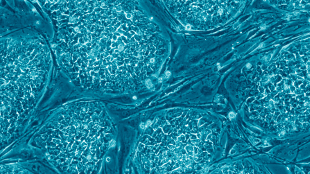 Human embryonic stem cellsWIKIMEDIA COMMONS, NISSIM BENVENISTY
Human embryonic stem cellsWIKIMEDIA COMMONS, NISSIM BENVENISTY
Older, established lines of human embryonic stem cells (hESC), such as those that President George W. Bush approved for federal funding in 2001, are different in significant ways than more recently derived cell lines, according to researchers at the University of California, Los Angeles.
UCLA molecular biologist Amander Clark and her colleagues found crucial differences involving RNA functioning between six hESC lines that they developed in the past three years and cell lines derived prior to 2001. They report their results in this week's issue of Human Molecular Genetics.
Clark and her team focused on the process of X chromosome inactivation that every female stem cell undergoes during development. They confirmed that the established hESC lines had already undergone X chromosome inactivation prior to differentiation, but discovered that the process itself—which usually entails non-coding RNA activity and a special form of...
More-recently derived stem cell lines can develop to a point where one of their X chromosomes becomes inactivated, but Clark and her team demonstrated a protocol, using small molecules, for preventing the new cell lines from undergoing the process. Maintaining pluripotent cell lines that retain both X chromosomes could be crucial for studying X-linked diseases, according to Clark. "Our data highlights the importance of maintaining human embryonic stem cell derivation efforts," Clark and her coauthors write in the paper. "Gold standard human embryonic stem cell lines should be the benchmark for all human pluripotent stem cell research."




